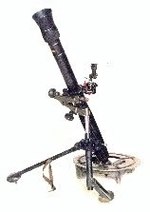This article needs additional citations for verification .(June 2025) |
| Danish International Brigade | |
|---|---|
| Danish: Den Danske Internationale Brigade | |
 Armpatch and logo | |
| Active | 1994-2005 |
| Disbanded | 2005 |
| Country | |
| Branch | |
| Nickname(s) | DIB |
The Danish International Brigade (Danish : Den Danske Internationale Brigade), short DIB (also sometimes known as the Danish Reaction Brigade) was a Danish military brigade. [1]
Contents
The political decision to form this brigade was conceived in the Danish Defence agreement 1992–1995. The formal decision to form the Brigade was made by the Folketing on 25 November 1993 and this date is often regarded as the birth of the Brigade. The Brigade was then formed, with staff and all subunits from the dispand 2.Zealand Brigade (2.SBDE) on 1 July 1994.
The background for its existence was changes in NATO's structure, in the European security situation and as a direct response to Denmark's involvement in UNPROFOR.
The purpose and design of the Brigade was to, in part or as a whole, to rapidly deploy in peacemaking, peacekeeping, humanity or similar missions under NATO, UN, OSCE or national supervision. In its lifespan the Brigade was never deployed as a whole but all subordinated units was deployed more than once.
On 1 January 1996, the Brigade was also assigned to the NATO Allied Command Europe Rapid Reaction Corps and fell under the organisational control of 1 (UK) Armoured Division when required. The DIB headquarters was located at Vordingborg barracks and made regularly exercises with 1 (UK) Armoured Division.
The DIB consisted of 4,800 personal, including a combat group of around 2,500 personnel in three battalions; a battalion equipped with Leopard 2A5 DK main battle tanks and an artillery unit with 18 self-propelled 155mm M-109 A3 howitzer, as well as logistics.
In all the Brigade had 51 Leopard 2A5 DK (Original 50 Leopard 1A5), 180 M113 (M113A1 with Add-On-Armour, M113A2 DK I (PNMK M/92) and M113 G3 DK) and 22 Mowag Piranha armored personnel carrier in various configurations and another ca. 1200 vehicles.
80% of the brigade consisted of volunteers who agreed to participate in up to two possible six-month international deployments during their four-year reserve commitment (originally this was only three years).
In the Danish Defence agreement 2005–2009, the brigade was to be dissolved and the Brigade thereby official ceased to exist on February 15, 2005. The Brigade-Staff was merged with the Staff of 1.Zealand Brigade (1.SBDE) (also terminated), to form the Staff in the newly erected 2. Brigade.












